Discovering Baking Soda: Fun Experiments for Kids


Intro
Baking soda, or sodium bicarbonate, ain't just for cookies and cleaning. This common household item has a multitude of fun and educational uses that can spark a child's imagination while also imparting fundamental scientific concepts. Whether you're a parent looking to keep little hands busy or a teacher seeking creative ways to engage students, baking soda can serve as a gateway to the fascinating world of science.
From fizzy rocket experiments that demonstrate chemical reactions to simple household tests of acidity and alkalinity, there's no shortage of creativity to tap into. The beauty of baking soda is its versatility—it's easily accessible, safe to use, and can turn a mundane afternoon into an exciting exploration of science. Let's dive into the myriad ways baking soda can make learning more interactive and enjoyable!
Understanding Baking Soda
Baking soda is more than just a common kitchen ingredient; it serves as a bridge between everyday cooking and the fascinating world of chemistry. This section aims to provide insight into what baking soda is, why it's essential, and the science that makes it tick. Knowing about baking soda equips parents and caregivers with tools and ideas to engage children in learning, making it a powerful ally in both the kitchen and the science lab.
What is Baking Soda?
At its core, baking soda is a simple white powder known scientifically as sodium bicarbonate. It is an alkaline compound, which means it can neutralize acids. This property makes it invaluable in various culinary applications, from baking delicious goods to acting as a leavening agent. When combined with an acid, such as vinegar or lemon juice, it releases carbon dioxide bubbles, making batters rise and give baked products their light and fluffy texture.
The importance of understanding baking soda extends well beyond just cooking. It serves as a springboard for teaching children about chemical reactions and the changes that take place when different substances interact. Incorporating activities with baking soda can plant the seeds of scientific curiosity, inviting young minds to explore further.
The Science Behind Baking Soda
Baking soda's benefits in educational settings lie in its unique chemical properties. Here, we’ll break down its composition, how it interacts with acids, and its role in baking, all of which illuminate the diverse applications of this remarkable substance.
Chemical Composition
The chemical formula for baking soda is NaHCO₃, which stands for sodium bicarbonate. This little compound has a big impact in the kitchen and beyond. The beauty of sodium bicarbonate lies in its simplicity. It consists of sodium ions, bicarbonate ions, and can facilitate various chemical reactions, making it a versatile choice for a variety of applications.
One of its key characteristics is its ability to function as a raising agent. This characteristic can be beneficial when teaching children about the basic principles of cooking. Involving kids in baking or cooking projects not only gives them a sense of accomplishment but also engages them in an interactive learning experience.
How It Reacts with Acids
One of the standout features of baking soda is how it reacts with acids. When baking soda encounters an acid, a chemical reaction occurs, resulting in the production of carbon dioxide gas. This release is what causes doughs and batters to rise, transforming dense mixtures into airy, fluffy creations.
For educational purposes, demonstrating this reaction can be tremendously fun and informative. A simple experiment with vinegar and baking soda, perhaps in the form of a homemade volcanic eruption, showcases the immediate results of this reaction, making chemistry accessible and enjoyable for young learners.
Applications in Baking
Baking soda's application in cooking is perhaps its most well-known role. In recipes, it often appears alongside acidic ingredients to create that wonderful leavening effect. Its ability to create carbon dioxide when heated allows bakers to achieve the desired texture.
This specific aspect of baking soda not only helps in cooking but also provides a fantastic opportunity for children to understand essential baking techniques. Watching the dough rise or cookies spread can become a memorable experience that highlights the principles of science in the kitchen.
"Baking soda is not just about making cookies rise; it’s a lesson in chemistry waiting to happen."
By exploring the connections between baking soda and cooking, children can develop an appreciation for both the craft of baking and the science underlying their favorite dishes. As they observe firsthand the effects, they form a deeper understanding of the importance of measurements and the chemical interactions behind the scenes.
Understanding baking soda and its properties lays the groundwork for numerous fun experiments and engaging culinary projects. Whether it's stirring up a tangible science experience or whipping up a tasty snack, the value of baking soda extends far beyond the pantry shelves.
Baking Soda in Experiments
Baking soda isn't just an ingredient for fluffing up cakes or cookies; it serves a much grander purpose in the realm of experiments. Using baking soda in experiments adds a layer of fun and education that engages young minds. It acts as a powerful tool to demonstrate fundamental scientific principles in a way that feels more like play than learning. The bubbling reactions and surprising results spark curiosity, prompting children to ask questions and seek deeper understanding. This curious mindset is the gateway to effective learning, turning ordinary kitchen materials into extraordinary scientific resources.
Basic Experiments for Kids
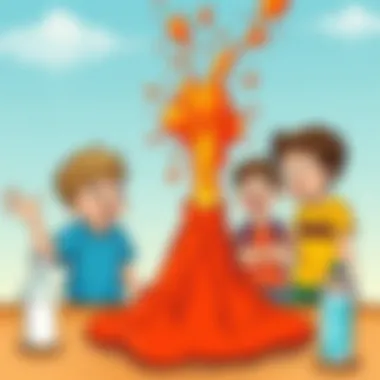
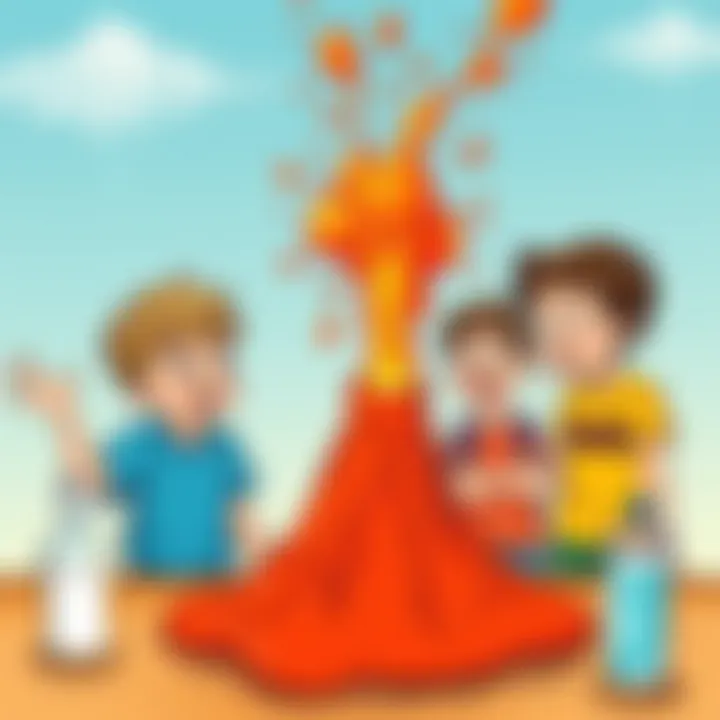
Volcanic Eruption Experiment
The Volcanic Eruption Experiment is a classic, and for good reason. Using common household items, it simulates a volcanic eruption, providing a visual spectacle that captures the attention of kids. In this experiment, the baking soda reacts with vinegar, creating an explosive fizz that resembles lava spewing from a volcano. The key characteristic of this experiment is its ability to make complex processes, like chemical reactions, accessible and memorable to young learners.
The advantage of this experiment lies in its simplicity and adaptability. All you need are a few basic materials: baking soda, vinegar, and a container to act as the volcano, which can even be made with clay or cardboard. On the flip side, it does create a bit of mess, which may require some cleanup. However, the excitement it generates often overshadows this minor inconvenience.
Baking Soda and Vinegar Reaction
The Baking Soda and Vinegar Reaction is a fantastic basic chemistry exercise that serves as an excellent introduction to acid-base reactions for kids. When mixed, baking soda, a base, reacts with vinegar, an acid, to produce carbon dioxide gas. This gas creates bubbles, leading to a frothy explosion in the confines of a cup or container. This reaction is a beneficial choice as it clearly illustrates fundamental scientific concepts of reaction dynamics in a visually captivating manner.
One of the unique features of this reaction is that it can be used for various activities – from creating fizzing drinks to serving as a propellant for small model rockets. However, like the volcanic eruption, it may require a little supervision due to the mess generated. It's easy to get carried away, and it's best to keep towels handy for the aftermath.
Advanced Science Fair Projects
When it comes to advanced experiments, baking soda opens doors to a world of fascinating scientific inquiries. Projects in this section delve deeper, allowing inquisitive minds to explore complex principles while still having fun.
Exploring Gas Production
The Exploring Gas Production project is a step up from the basic experiments, encouraging students to examine how different variables affect gas output in chemical reactions. This project can involve varying amounts of baking soda or vinegar and observing the resulting gas produced. The key characteristic here is that it teaches the principle of measurement and the importance of thorough documentation in experiments. This elevates the activity from mere observations to structured scientific inquiry.
One notable advantage of this experiment is that it allows for hypotheses to be tested, a core component of the scientific method. However, the precision required can challenge some younger children, necessitating guidance and patience throughout the process.
pH Indicator Testing
The pH Indicator Testing project offers an exciting way to blend baking soda with other household items. This project showcases how baking soda can act as a pH indicator when mixed with various solutions, showcasing acid and base properties. The vibrant colors that emerge from the reactions provide a clear visualization of how pH shifts occur, making the learning process vivid and more engaging.
This project stands out as it demonstrates real-world applications of chemistry in everyday life. It empowers students to test substances they encounter daily, providing a tangible way to connect scientific concepts with the world around them. One downside, however, is the need for some additional items like cabbage juice or other natural pH indicators, which may not always be readily available in every household.
Baking soda transforms routine experimentation into eye-opening learning adventures, nurturing a child’s scientific curiosity.
In summary, from basic fizzing eruptions to advanced explorations of gas production and pH indicators, baking soda presents a versatile platform for engaging young scientists. These hands-on experiments stimulate inquiry, making the abstract elements of science more approachable and enjoyable.
Creative Uses of Baking Soda
Baking soda is not just a common ingredient found in the pantry; it is a versatile substance with numerous creative applications. This section highlights the importance of using baking soda in artistic endeavors and science-related activities. The creative uses of baking soda can serve as an engaging avenue for kids to explore scientific principles while also letting their creativity run wild. By combining art and science, parents and educators can effectively nurture a child's curiosity and innovative spirit. Beyond its traditional uses, baking soda offers benefits such as being safe to handle, non-toxic, and easily accessible, making it a suitable choice for educational projects.
Art and Craft Projects
Making Baking Soda Clay
Making baking soda clay is a wonderful gateway into the world of crafting. The process of creating this clay involves simply mixing baking soda, cornstarch, and water, then heating it until it forms a dough-like consistency. This hands-on activity promotes fine motor skills in children while also allowing them to create sculptures, ornaments, or any imaginative crafts they can dream up.
- Key Characteristic: The flexibility of baking soda clay makes it a favorite among kids, as it can be easily molded into various shapes.
- Benefits: Another plus is the clay's quick-drying nature, enabling shorter project times and reducing wait times. Kids can paint it or leave it natural, which adds another layer of creativity.
- Unique Features: Unlike commercial clays, baking soda clay is lightweight and safe to use, allowing children to explore without fear of harsh chemicals.
The only downside is that this clay may not be as durable as traditional alternatives, so careful handling is necessary once it dries. Nevertheless, it serves as an excellent introduction to sculpting and texture for young artists.
Creating Textured Paint
Creating textured paint with baking soda is another stimulating project that can spark creativity. By mixing baking soda with acrylic paint, one can create a thick and textured medium that adds depth to artwork. This textured paint can enhance drawings and paintings, offering kids a tangible way to see and feel their art.
- Key Characteristic: The ability to add volume and texture to a painting is what sets this project apart.
- Benefits: It provides a unique experience, enabling kids to explore mixed media techniques, as they can blend colors and create 3D effects on flat surfaces.
- Unique Features: Additionally, using baking soda makes the paint quick-drying, reducing the waiting game that often frustrates young creators.
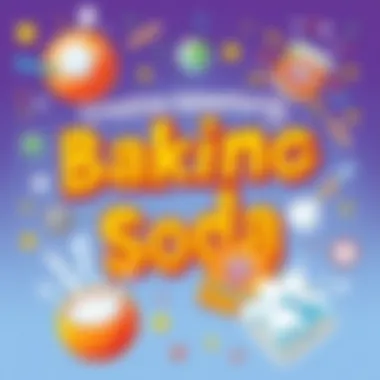
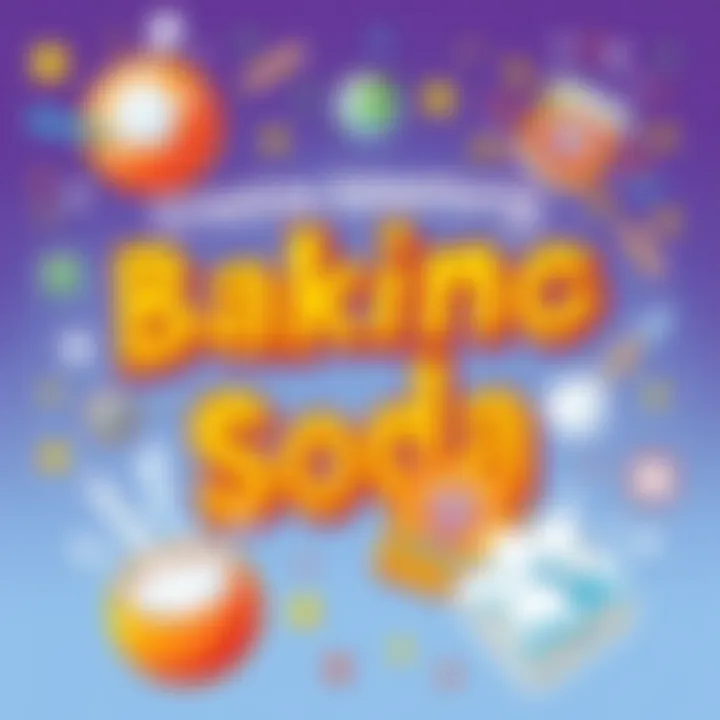
Some negatives include potential clumping if not mixed properly and the paint being more challenging to remove from surfaces than traditional paint. Yet, the overall experience of creating and experimenting with textured paint leads to a fun exploration of colors and creative expression.
Fun with Science in the Kitchen
Homemade Fizzy Drinks
Homemade fizzy drinks can be both refreshing and educational. By using baking soda in a DIY fizz mix, children can see firsthand the reaction between baking soda, vinegar, or citric acid. This exciting science in the kitchen demonstrates basic chemical reactions while also resulting in an enjoyable beverage.
- Key Characteristic: Kids get to experience the joy of watching the fizzing action in real time.
- Benefits: This activity highlights the creation of carbon dioxide, helping to explain fundamental elements of chemistry naturally. Moreover, kids get to personalize their drinks with flavors, adding to the fun.
- Unique Features: The simplicity of the ingredients means that this can be done with items usually found around the house, making it easily repeatable.
However, be aware that the fizzing can create a bit of a mess if not controlled carefully. It's all part of the learning process though, fun accidents can lead to memorable lessons!
Chemical Reactions in Cooking
Engaging children in cooking can open the door to discussions about chemical reactions, particularly those involving baking soda. Whether in baking bread or making biscuits, the role of baking soda in creating rise and texture illustrates these reactions beautifully.
- Key Characteristic: It allows kids to understand the science of food while getting practical experience in the kitchen.
- Benefits: The thrill of baking can be a motivating factor, as the exciting transformations—how batter rises and becomes something delicious—help solidify their learning.
- Unique Features: With baking soda, kids learn to measure, mix, and observe, which fosters essential kitchen skills.
Safety Measures
Incorporating baking soda into fun activities and experiments is a whole lot of fun, but it’s essential to keep safety top of mind. Safety measures ensure that learning and exploration can take place without unnecessary risks. Understanding how to handle baking soda, store it properly, and supervise its use is critical, especially when working with kids. Safe practices lead to successful experiments and creative projects. Here’s a deep dive into these safety measures:
Handling Baking Soda
Proper Usage
When using baking soda, proper usage is key. This means not only using the right amount in recipes or projects but also knowing when and where it should be utilized. The most notable aspect of proper usage is its versatility. Whether it’s for baking, cleaning, or science experiments, understanding the intended purpose shapes how effective the outcome can be.
One major benefit of proper usage is that it encourages accuracy. For instance, when baking, using too much baking soda can result in a bitter taste or an undesirable texture. That said, its role in reactions—like with vinegar—can demonstrate exciting science concepts without exact measurements worrying you. Also noteworthy is the fact that baking soda is generally safe to handle with minimal risk, making it a popular choice in educational activities.
Still, while most characteristics make it user-friendly, overusing the substance can cause negative results. For instance, if injecting it into a vinegar experiment, the reaction could overflow messily if not controlled.
Storage Recommendations
Just as crucial as using baking soda properly is how you keep it stored. Storing baking soda correctly can extend its usefulness and effectiveness. A key characteristic of smart storage is keeping the product in a cool, dry place. Moisture can cause clumping, which makes it less effective when you want to use it.
This storage tip is beneficial because it ensures the baking soda remains fresh for various applications, from cleaning agents to culinary uses. An unique feature of proper storage is also having it sealed tightly. This keeps out contaminants, enhancing its shelf life. However, neglecting storage by leaving it open or in damp conditions can diminish its ability to perform in reactions, particularly in experiments where precise measurements are paramount.
Supervision Guidelines for Experiments
Supervision is non-negotiable, especially when experimenting with baking soda and other reactive substances. Children may be unsure about the correct way to handle materials, making guidance essential to a safe experience. Having an adult or responsible teenager nearby can prevent accidents from occurring.
- Always be present during the experiment to ensure safety protocols are followed, allowing kids to explore while knowing someone is watching.
- Encourage kids to ask questions if they are unsure about any step, promoting a learning atmosphere.
- Introduce them to the concept of "safety first" by discussing what to do in case of an accidental overflow or spill.
By enforcing these supervision guidelines, you foster an environment that not only encourages experimentation but also teaches the importance of caution in science and beyond. Safety is not just a rule but a way to enhance learning, creating both enjoyable and meaningful experiences with this versatile ingredient.
Exploring the Chemistry of Everyday Life
Understanding how baking soda fits into our daily routines reveals a lot about its usefulness. This section elaborates on how this commonplace item can transform mundane household tasks into fascinating science lessons. Baking soda serves not just as a versatile product but also as a gateway to uncovering the hidden chemistry that runs through our lives.
Baking Soda's Role in Household Products
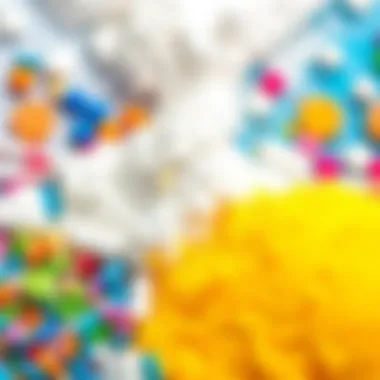
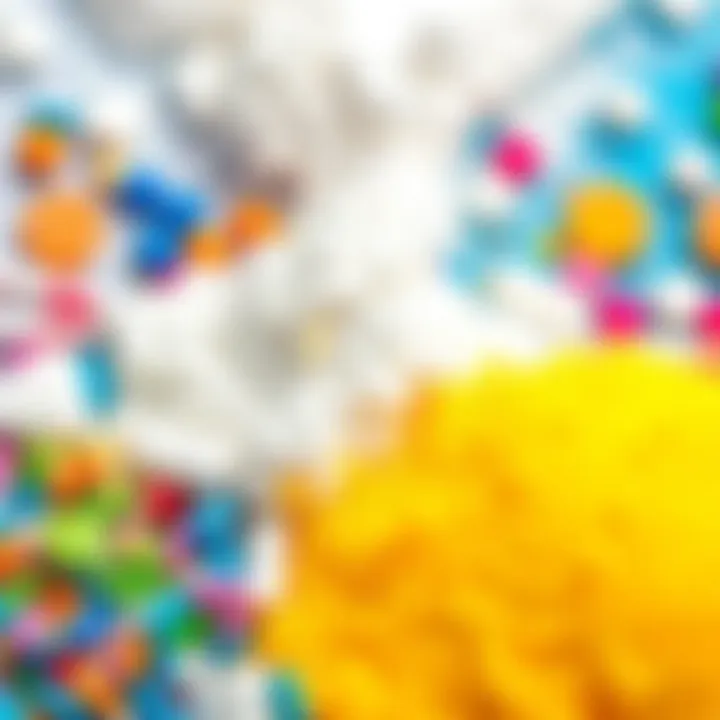
Cleaning Agent
Baking soda shines in its role as a cleaning agent. One of the main reasons it stands out is its gentle abrasive properties. This means it can scrub away grime without scratching surfaces, making it an excellent choice for cleaning delicate items like glass or porcelain.
Moreover, it interacts with acids and bases, which amplifies its cleaning power. For instance, when combined with vinegar, it can create a bubbling reaction that loosens dirt and stains. Many people prefer baking soda because it is non-toxic, making it safe around children and pets. Unlike harsh chemical cleaners, it does not release harmful fumes, which is a big plus for many households.
One unique feature of baking soda as a cleaning agent is its ability to neutralize odors. Scrubbing a surface with it effectively cleans but also leaves the area smelling fresh. Although it has impressive advantages, it may not be effective on all surfaces. For instance, it might struggle with tough, stuck-on food or heavy grease, requiring additional scrubbing or different cleaning products.
Deodorizer Functions
Baking soda's deodorizing abilities are another reason why it's a household favorite. It works like a charm for removing unwanted odors from the fridge, carpets, and even shoes. When baking soda comes into contact with odor-causing compounds, it can neutralize them, rather than just masking the scent.
Its widespread popularity comes from its effectiveness and affordability. A small box can last quite a while, and it doesn't take much to do the job. You can sprinkle it in your fridge or mix it in a solution for a fast spray. Unlike many air fresheners that rely on synthetic fragrances, baking soda leaves behind a clean, fresh smell, which is appreciated by many.
Still, one could argue that it may require a bit more effort to see results. Simply placing an open box in the refrigerator won’t get rid of particularly strong odors without some active usage like scrubbing or spraying mixed solutions. However, considering its low cost and natural composition, the challenges it comes with are often worth the reward.
Connection to Broader Scientific Concepts
Exploring baking soda reveals much about significant scientific concepts that apply to numerous scenarios.
Acid-Base Reactions
One informative area is acid-base reactions. Baking soda acts as a base when mixed with acidic substances. This reaction is particularly noticeable when it interacts with vinegar, creating carbon dioxide bubbles. This chemical reaction illustrates fundamental concepts of chemistry, especially to young learners who are just getting familiar with scientific exploration.
The educational aspect of this characteristic is immensely beneficial. It’s not merely about cooking; it serves as a simple demonstration of how acids and bases interact in the real world. Conversely, while engaging with these reactions, one should be cautious not to mix too much too quickly, as the bubbling reaction can become vigorous. This characteristic of baking soda serves as a mesmerizing yet safe way to introduce kids to the basics of chemical interactions.
Carbon Dioxide Production
When baking soda reacts with an acid, it produces carbon dioxide gas. This is not merely a fun reaction; it’s fundamental to many cooking processes, especially in baking! When baking soda is combined with acidic ingredients like yogurt or lemon juice, it releases carbon dioxide bubbles, causing dough to rise.
This unique feature connects cooking to chemistry elegantly and demonstrates the practicality of scientific principles in everyday life. Understanding this allows kids to appreciate the transformation of ingredients and the magic behind baking. However, this reaction might not always be predictable, sometimes requiring precise measurements and conditions for the desired outcome.
"Baking can be a delightful introduction to chemistry, where kids can see reactions unfold before their eyes, merging science with hunger!"
Final Thoughts
Baking soda is often seen as just a common household item, but delving into its versatility reveals a goldmine of educational opportunities. This article highlights how baking soda can serve as a bridge connecting everyday life with the wonders of science. When utilized in experiments and creative activities, it allows children to observe reactions firsthand, fostering their curiosity and strengthening their understanding of fundamental scientific principles. The playful nature of these activities makes learning feel less like a chore and more like an adventure, which is crucial for engaging young minds.
One of the stand-out benefits of incorporating baking soda into educational activities is its ability to simplify complex concepts. For instance, through the fun volcanic eruption or fizzy drink experiments, kids can see acid-base reactions in action without needing advanced knowledge of chemistry. The whimsical aspects of these experiments encourage questions like "Why does it bubble?" or "What would happen if we used lemon juice instead of vinegar?" These queries are signals of emerging scientific thinking, heightened by the immediate hands-on experience.
Moreover, safety and supervision considerations are paramount when involving children in experiments. Emphasizing the importance of adult guidance not only ensures a secure environment but also allows parents and caregivers to engage directly with their children’s learning process. This involvement can further solidify the parent-child relationship through shared discovery. By addressing safety while encouraging creativity, the educational experience becomes more holistic. Thus, the last impression left by integrating baking soda lessons is one of safety, enjoyment, and insights into the scientific world—all wrapped up in a fun package.
"Educational moments don’t always come from textbooks; sometimes, it’s the simple things that ignite a lifelong passion for inquiry."
The Importance of Engaging Young Minds
Engaging young minds is no small feat. Children today are often bombarded with screens and distractions, making it imperative for educational activities to stand out. Baking soda offers a unique allure due to its multifaceted applications. Not only does it play a role in the kitchen, but it also serves as a fantastic tool for experimenting. Fostering curiosity through these hands-on activities can lead children to discover their interests early on.
By combining science with everyday materials, such as baking soda, kids become active participants rather than passive learners. This engagement can spark a greater interest in STEM fields. The simple act of mixing baking soda with vinegar isn’t just fun; it encapsulates the essence of experimentation—hypothesis, testing, and observation all come into play. Such activities nurture critical thinking and problem-solving skills, essential for their academic journey and future careers.
Encouraging Further Exploration
Encouraging kids to explore beyond the basic experiments can lead them on a deeper scientific journey. Baking soda serves as an entry point into a vast world of exploration. After mastering simple reactions, young scientists can be inspired to formulate their own experiments. Perhaps they’ll ask, “What happens if I add more baking soda?” or “How does the temperature affect the reaction?” Each question is a stepping-stone toward understanding the scientific method and cultivating an exploratory mindset.
Moreover, parents and educators can foster this exploration by introducing related topics, be it chemistry, cooking or even environmental science. For instance, discussing how baking soda can clean household surfaces ties in chemistry with daily chores, teaching responsibility while also encouraging scientific thinking. To keep the momentum going, parents can provide resources or suggest visiting science museums, where children can see real-life applications of concepts studied at home. The aim is to create an ongoing dialogue about science and its relevance, so the curiosity sparked during these baking soda activities doesn't fizzle out as they grow older.
In summary, the importance of engaging young minds and encouraging further exploration cannot be overstated. These components work hand in hand to build a foundation for lifelong learning and curiosity, ensuring that the next generation is not just consumers of knowledge but active participants in the world of science.







